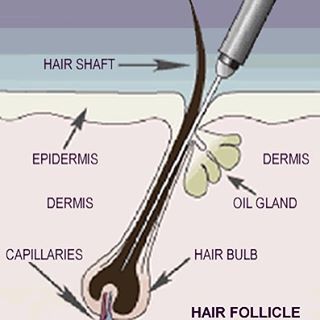Electrolysis Technique
Electrolysis Hair Removal
Electrolysis hair removal is only a permanent hair removal method that utilises electrical currents to target and destroy hair follicles. Unlike temporary methods like Laser/IPL, shaving or waxing, electrolysis aims to provide a long-lasting solution by removing the follicles’ ability to produce new hair. It involves using a fine, sterile needle inserted into individual hair follicles. A small amount of electrical current is then applied, targeting the root of the hair—this electrical current damages the hair follicle, inhibiting future hair growth. Electrolysis is a versatile technique suitable for all skin tones and hair types, including light or fine hair that may be challenging to treat with other methods. With its precision and ability to target specific areas, electrolysis ensures long-lasting and permanent results. It is a practical and versatile option for individuals seeking permanent hair reduction. The technique is performed by skilled professionals who prioritise safety and comfort, making electrolysis a trusted choice for those seeking a permanent solution to unwanted hair.
ONLY ELECTROLYSIS can remove the hair from the root and also destroy the stem cells of the hair follicle, thus leading to permanent hair removal of unwanted hairs.


There are three basic types of Electrolysis hair removal.
- Galvanic – A DC (direct) current passes through the needle. It charges the moisture (H2O) and salt (NaCl) naturally found in the follicle, causing a chemical reaction. Sodium hydroxide (lye) is produced. The lye destroys the hair follicle by chemical decomposition. This method precedes Thermolysis and is generally somewhat less effective and more uncomfortable for patients, requiring higher voltages.
- Thermolysis – An AC (is also called Short Wave Diathermy or RF diathermy in some countries) current passing through the needle causes vibration in the water molecules surrounding the hair follicle, producing heat. The heat damages the hair follicle. This is the quickest method, but areas will need to be covered more times than with Galvanic or Blend.
- Blend – This method combines the benefits of galvanic and thermolysis. It passes a DC current through the needle, producing lye, which is then heated by the AC. The heat spreads the lye around the follicle, ensuring proper damage to the hair follicle tissue. This is faster than Galvanic alone but still more time-consuming than Thermolysis.
Some common side effects of electrolysis are pain during the procedure (depending on the coarseness of the hair being removed and the sensitivity of the area), redness, and swelling.
Because hair grows in three different stages, multiple sessions are necessary to experience permanent and effective hair removal.
